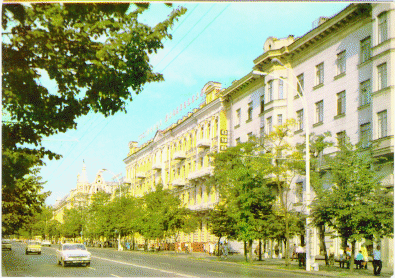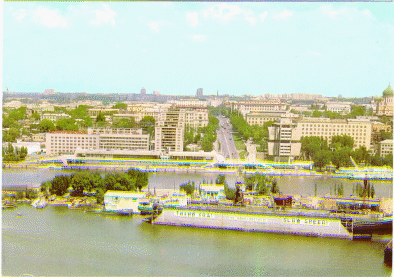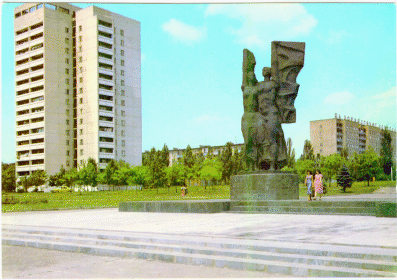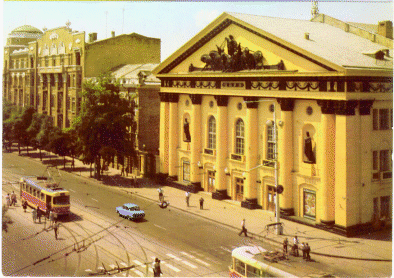 |
Oh, I can't just pass by: Rostov is my home city, a business center of the South. People call it "Gates to the Caucasus" since EVERYTHING that goes to the south must pass through this point on the map. Geographical location of the city is unique: it's got a river port, it's a junction of railways, highways, it has an airport. Get other info from www.icomm.rnd.su Some of it is quite interesting: for example, what kind of drink is the most popular in Rostov, what is considered a good cellular phone in Rostov, etc. but I warn you -- all this in Russian!
Valery Poltavtsev (who is an associate of mine) has established a page also devoted to Rostov. He has some more pictures and a good review of the city's being now.
Besides ...
Herod, the first among "serious" historians, visited Don steppes and gave a very precise description. He wrote about people known to the history at that time as Skyphes and as Anthes before. Don was called Thanais (the stress is on the pre-last syllabus: Tha-na-is) by Greeks. They established a settlement also called Thanais. It was the most remote Greek's colony on the North, and the remnants of the settlement can still be found in about 40 km eastward from Rostov. There are a permanent archeological station there, a museum and several other very nice things like old university's observatory and bio-station for students majoring in biology. For the detailed information, please, see the pages on the Rostov University WWW server. There are available in mostly Russian but there are some translations into English.
Because Thanais occupied one of the most convinient places for the trade, it was owned by different people during its history of about 500 years. Upon 375 it was totally destroied by goonn tribes and never restored again.
By IXth century Russians started to appear there with a great deal of interest. They build some settlements; in Xth century the last Russian pagan Prince Sviatoslav won a war with Khazars who disturbed the southern borders of the state. Since this victory the whole land is owned by Rus, although tribes of nomads appeared there for quite a long time. However, not only Sviatoslav visited Don; many Russian Princes took a great deal of care about Southern borders. In 1184 prince Igor was trying to go directly to the center of nomand's "state", but he did not succeed, was taken as a hostange and staied inprisoned for quite a while. Those events are very nicely described in a "The Word about Regiment of Igor" and I recommend to read this manuscript translated into many languages and published.
In 1224 the land saw a great fight between Russians and Tatars. Russians had lost on banks of a river that is now known as Kalmius. In 13 years the second Tatar invasion occured which was a beginnig of the most terrible period in Russia's history. Tatar's power was suspended only after 1380 when Dmitry Donskoy, the Great Prince of Russia, had won a battle on the Kulikovo field.
Being owners of the land Tatars allowed trade there since it would be totally stupid not to -- geographical location of the region is unique. Italians had established a small town called Porto Pizano approximately at the same place where Thanais was, merchants from Venice had built a colony known as Thana right on the place where the City of Azov is now -- on the left side of the Don's mouth. Thana became a very beneficial place very soon; that had made it one of the center of trades between Europe and Asia. However, Thana's wealth was a magnet for nomad tribes which finally had destroied the city in 1395. People were trying to restore Thana but Turks took it over, and since then except for the Azov Fortress the place became look like a desert.
XIVth century was a great time for the steepes. Russian goverment was in need of making these lands secure enough. That was a reason to organize a Border Survice. Futhermore, people were flowing there themselves: almost free land for those who was not satisfied with a state order. So... people ran away and became cossaks. It is known, however, that after Golden Ord fell Russians who were enslaved there staied at those places and created settlements and future cossak traditions. In 1637 cossaks took Azov back from Turks and became full owners of the city.
Although cossaks were very brave, Turks kept the coast of Azov Sea. So, Peter the Great went there twice (1695 and 1696). The result was a total liberation of southern steepes. Peter started to build a port known as Taganrog. Turks were very "upset" and in 1711 Taganrog, Azov and all left coast were taken again. The patience of Russians was lost (it's a generic rule, by the way) upon 1735: Russia started a new war with Austria as an ally. Austrians had lost in several battles and initiated a peace process with Turkey. France was a mediator on these talks having its own interests -- it did not want Russians on the south, near Konstantinopol. Russia could not continue the war without allies, and almost all lands returned to Turkey except for the tiny point -- the Fortress of Sent Anne.
In times of Elizaveta several custom houses were established there; one of them became a progenitor of the city of Rostov in 1749. In 1750 Russian Commerical Company appeared at those places. The company had a monopoly on trades with Konstantinopol but everybody who had shares of the company was able to make a deal also. In 1761 Elizaveta issued an order to establish a fortress of Sent Dmitri Rostovski which was an official acceptance of the settlement existed much long before.
(To be Continued)
 |
It's a central street of Rostov known as Bol'shaia Sadovaia. For quite a while, it was called Engels' street -- well, bolsheviks tended to rename everything and assign names of their leaders.
 |
This is a view of the city from south. You can see Don river, a port, and a prospect known as Bol'shoi but it is still not renamed back and you will find that people call it Budionovski. Anyway, everything has it's time.
 |
This monument was built in an honor of the friendship between Bulgaria and Russia. Rostov and Bulgarian city Pleven are sister-cities. Moreover, when we talk about Bulgaria and Russia we all recall liberation of Bulgaria from Turks which ended Turk's control over a great part of the Black and Azov Sea costs. I have been in Pleven myself, and it's a very nice city. If I'll find picturs of it they will definitely be here!
 |
You could probably guess what it is. It's a circus! Yes, grab your kids and go!
Please, click here to go further.